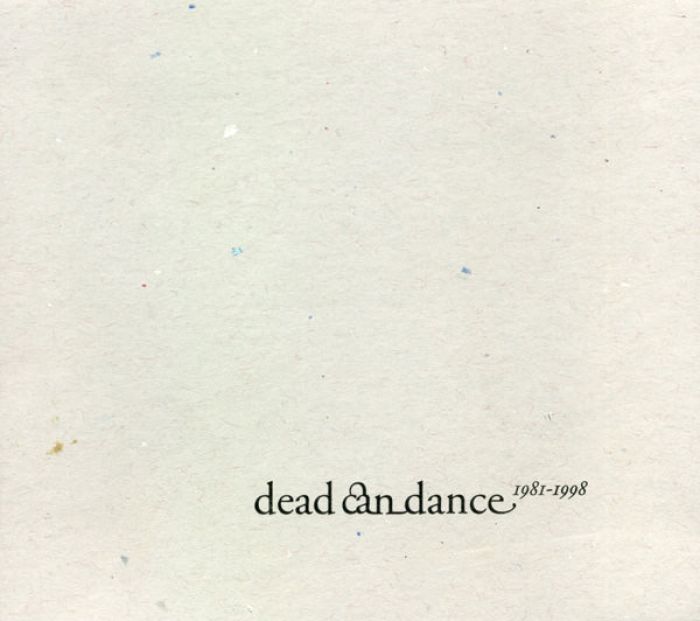Dead Can Dance (1981-1998) by Dead Can Dance (Review)

At the end of the copious liner notes that come with this stunning box set, there’s a quote from 4AD founder Ivo Watts-Russell: .”..more than anybody that I’ve worked with, Dead Can Dance have been put on this planet to make music.” The very nature of that quote implies something preternatural is going on within this group’s music. Throughout their career, Lisa Gerrard and Brendan Perry have transversed space and time, continents and centuries, in order to craft their unique musical vision. It’s a vision both sensual and divine, and rendered in loving detail throughout these 4 discs.
4 discs might seem like a little much for any band, but given Dead Can Dance’s diverse, extensive catalog, it feels just about right. Assembled in chronological order, the set shows both the duo’s evolution from Joy Division-inspired post-punk to ethno-medieval musical trailblazers as well as their unified vision of making music that was something beyond mere entertainment, but rather something spiritual and truly alive (as implied by the band’s name).
The first disc contains Dead Can Dance’s earliest efforts, and are a far cry from the fusion of sounds they would later achieve. Rather, the music’s dark rhythms and chiming guitars owe more to Joy Division and Bauhaus than, say, Hildegard Von Bingen and Nusrat Ali Fateh Khan. However, by “In Power We Entrust The Love Advocated” (Garden of the Arcane Delights), Dead Can Dance’s love for the music of the Renaissance becomes obvious. As the disc progresses, touching on albums such as Within the Realm of a Dying Sun, it’s easy to see how Dead Can Dance became such a huge influence in goth and darkwave circles. Arcana, Arcanta, Chandeen, Ordo Equitim Solis, and so many others all owe a huge debt.
But unlike many of their followers, Dead Can Dance never fit very comfortably within the “goth” genre; they were about as “goth” as The Cocteau Twins. When Dead Can Dance wove esoteric philosophy and symbolism, as on Spleen and Ideal, it was out of an interest to see how these philosophies might enhance and enrich the music, not just an attempt make it darker or more obtuse. Their music was characterized by both its intelligence and sensitivity.
Even when they employ pretentious lyrics — “We scale the face of reason to find at least one sign/That could reveal the true dimension of life lest we forget… We lay by cool clear waters and gazed into the sun/And like the moth’s great imperfection succumbed to her fatal charms” (“Anywhere Out of the World”) — it’s sung with the solemnity of a religious procession, and with as much conviction.
This is best seen on the second disc, which showcases the finest material of Dead Can Dance’s catalog. The first half of the disc falls quite nicely in line with where the first disc left off. “The Host of Seraphim” could be a soundtrack for St. Theresa’s ecstasies, while “Saltarello” feels like it was recorded right out of a 17th century Italian circus. But the second half displays Dead Can Dance at the height of their powers, as they began to open their musical palette and explore the music of other cultures. This expansion led to Into the Labyrinth, their most coherent album, as well as their commercial breakthrough.
“Yulunga” just sounds ancient and reverent, as Lisa Gerrard’s magnificent voice strikes up a wordless chant over tribal percussion and somber strings. There’s something primal and mysterious about this piece; it plays like the final relic from some long lost civilization. “The Ubiquitous Mr. Lovegrove” is essentially a bitter love song, but sung against middle-eastern drones and whiplash percussion. “The Carnival is Over” plays like Dead Can Dance’s most intimate song, a carnival-esque ode to childhood and wonder sung in Brendan Perry’s deep, rich voice. And Lisa Gerrard delivers one of her most stunning vocal performances on “The Wind that Shakes the Barley.” Her rich, powerful voice captures the tragedy of this old folk ballad so perfectly you forget that it was recorded live for radio.
The third disc covers the final recordings of Dead Can Dance’s career; the live album Toward the Within, and Spiritchaser, their last studio album. The highlights on this disc are regrettably few and far between, with most of them coming from the live material (most notably the stunning “Sanvean,” another showcase for Gerrard’s operatic vocals).
Unfortunately, Spiritchaser’s material always feels lacking, especially when compared to the rich symbiosis of Into the Labyrinth. Largely influenced by African and South American music, as well as various percussive forms, songs like “Nierika” and “Song of the Nile” stray way too close to the all-enveloping folds of “world music.”
That’s not always the case; at times, the rhythmic patterns and chants become almost hypnotic, reminiscent of Robert Rich’s world ambience. But it still lacks much of the potency that filled Dead Can Dance’s earlier works. That’s a shame, since “The Lotus Eaters,” the one surviving track from the post-Spiritchaser sessions, develops Spiritchaser’s sound and hints at some lovely possibilities.
The 4th disc is actually a DVD, featuring the live concert video for Toward the Within, as well as some music videos. The music videos are interesting to watch, especially the one produced for “The Carnival is Over.” But the live video is a real treat, and truly displays Dead Can Dance’s power. If anything, watching Lisa Gerrard perform, her voice just as beautiful as it is on the recordings, is worth the price alone.
Watching them work their magic in a live setting, capturing that same rare power their albums hold so often — well, it does more to explain and document Dead Can Dance’s magic than any mere review ever could hope to.